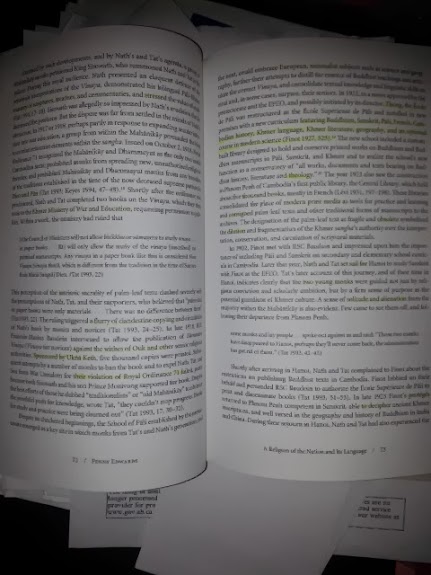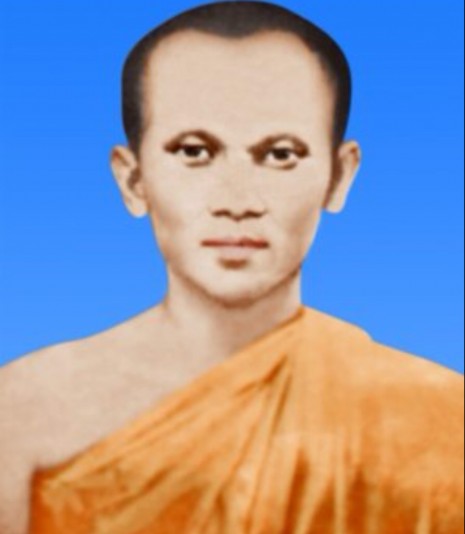December, 2013
now browsing by month
Samdech Chuon Nath: Leadership Pioneer for the 21st Century
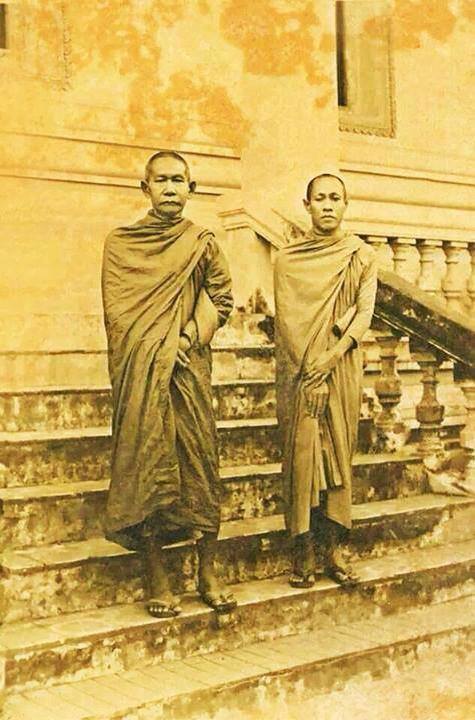 Samdech Chuon Nath or Supreme Patriarch Chuon Nath is very well-known in Cambodian society for his deep knowledge in Khmer language, Buddhism and modernity. Among his historical legacies, the initiative on translating Pali text into Khmer language and his encouragement in socially engaged Buddhist monks, have been presently practical. His initiative in translating Pali text into Khmer language for common people to understand the Buddha’s teaching, has created more space of comprehension among Buddhists and politicians. During the reign of King Norodom Sihanouk, his leadership was called Sangkum Reastr Niyum or People Oriented Society, or sometime Buddhists Oriented Society. Motivation behind Samdech Chuan Nath, was an effort of French protectorate to discontinue the Buddhist brain-drain to Thailand. Zusan Kapele, Fino, Cedes and many other French scholars were well-known in restoring Khmer legacies, spirit of belonging, nationalism and sense of unity. However, Samdech Chuan Nath, Samdech Huat Tat and many other Buddhist scholars were impregnable erudite reformists for new effective leadership to build Cambodia and to free this country from French eventually.
Samdech Chuon Nath or Supreme Patriarch Chuon Nath is very well-known in Cambodian society for his deep knowledge in Khmer language, Buddhism and modernity. Among his historical legacies, the initiative on translating Pali text into Khmer language and his encouragement in socially engaged Buddhist monks, have been presently practical. His initiative in translating Pali text into Khmer language for common people to understand the Buddha’s teaching, has created more space of comprehension among Buddhists and politicians. During the reign of King Norodom Sihanouk, his leadership was called Sangkum Reastr Niyum or People Oriented Society, or sometime Buddhists Oriented Society. Motivation behind Samdech Chuan Nath, was an effort of French protectorate to discontinue the Buddhist brain-drain to Thailand. Zusan Kapele, Fino, Cedes and many other French scholars were well-known in restoring Khmer legacies, spirit of belonging, nationalism and sense of unity. However, Samdech Chuan Nath, Samdech Huat Tat and many other Buddhist scholars were impregnable erudite reformists for new effective leadership to build Cambodia and to free this country from French eventually.
At the presence, many Khmer monks have waken up to follow the trace of Samdech Chuon Nath, Khiev Chum and other monks in reforming this society to be sustainable socio-economic development, free, fair, equal, just and democratic etc.
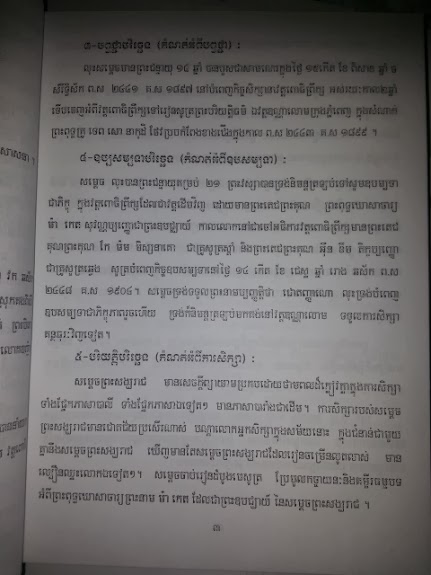
Biography of Samech Chuan Nath. For details, read Transcription Book of Khmer language interviewing of Samdech Chuan Nath by Dr. Long Seam and his colleagues.
Posted in Culture, Education, Leadership | Comments Off on Samdech Chuon Nath: Leadership Pioneer for the 21st Century
Tags: Samdech Chuon Nath
Reflection of Political Leadership of Cambodia from Past to Present
Pre Angkor and Post Angkor Political Leadership
At school, Cambodian children have learnt about many Khmer heroic Kings during the pre Angkorean period. For instance, King Jayavarman II, after escaping from the abdication of Java or Sailendra Kingdom, he made a long march across Cambodia to calling for a people power to fight against Sailendra occupation, and to proclaim back sovereignty of his Kingdom. It is said that he was raised and grown up in Sailendra but he eventually declared independence at Mahendra mountain (Phnom Kulen) to free from Sailendra. He began strengthening his Kingdom by building Mahendraparavata capital city with the installation of a sacred Linga of the Nation named “Devaraja”. From this period of 802 as inscribed in the stone, Cambodia enjoyed prosperity and candid strength in the region.
For post Angkorean period, Cambodia was seen as very fragile and dividing. According to palm leaves records, more than 700 years, Khmer Kings and leaders turned to fight against each other by asking Thai and Vietnam to back their cause.
However, this behavior was halted during the reign of King Ang Duong who projected his political leadership differently. He was raised and grown up in Thailand, his ascending to throne was expected in the same previous Kings. But the King secretly contacted France who was initially not interesting in this region at all. The history tells that the King failed at the first time because his messenger was killed by Thai authority. However, his second attempt was successful and French arrival was signed to be the protectorate of Cambodia. French fought with Siam and helped discard the power of Siam ever existed in Cambodia.
However, French arrival was not dislocated the power line between Vietnam and Cambodia. Under the French’s policy of Indo-China, Vietnam enjoyed most domination over Cambodia and Lao. This embedded legacy has affected on Cambodian political leadership until nowadays.
Current Cambodian Political Leadership in Reflecting Post Angkorean Era
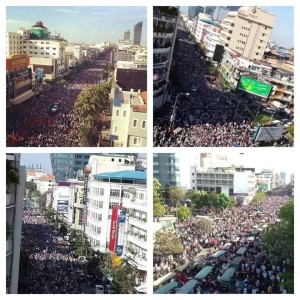
From my whole life, I have observed that Cambodian politics has played hard line approaches. This time, when the authority has allowed peaceful mass demonstration to march freely for few days and the participants visibly increasing, they come up with this idea “Coup” or an attempt to overthrow the government which is explicitly threatening. By definition, the peaceful mass demonstration could not be called an attempt to coup (detat) at all.
I observe the hard-line politics has been used in Cambodia since the election in 1993. Often,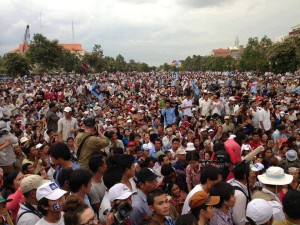 it is not dangerous if Cambodian politicians are contendering with one another, but for Cambodia, some of her leaders have always been seen so subservient to the third party (outsider). The crisis of 1993 election happened because of an attempt to separate Eastern zone plus the bloody coup detate in 1997 which was visibly involved as our Premier televised in soldier uniform from Vietnam plus the pressuring to sign additional border treaty in 2005 in which many activists were jailed. These three examples exhibit clearly on the leadership of powerful third hand. From time to time, any Cambodian activists who are outspoken about the Koh Tral island or Eastern border line, they will be ended by jailing, life threatening or fleeing the country to avoid criminal sentencing. I listened RFA Forum this Dec.22 (watch clip below) and had chance to listen to our Premier’s speech on his logic on giving up the claiming back of Koh Tral very brokenhearted.
it is not dangerous if Cambodian politicians are contendering with one another, but for Cambodia, some of her leaders have always been seen so subservient to the third party (outsider). The crisis of 1993 election happened because of an attempt to separate Eastern zone plus the bloody coup detate in 1997 which was visibly involved as our Premier televised in soldier uniform from Vietnam plus the pressuring to sign additional border treaty in 2005 in which many activists were jailed. These three examples exhibit clearly on the leadership of powerful third hand. From time to time, any Cambodian activists who are outspoken about the Koh Tral island or Eastern border line, they will be ended by jailing, life threatening or fleeing the country to avoid criminal sentencing. I listened RFA Forum this Dec.22 (watch clip below) and had chance to listen to our Premier’s speech on his logic on giving up the claiming back of Koh Tral very brokenhearted.
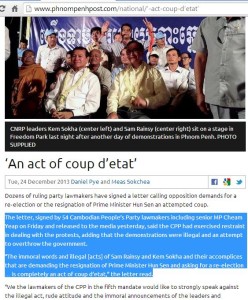
As we are Cambodians and we are working to protect Cambodia land and to protect our Constitution, why we condemn our own people who are sharing our common emotion and mentality? Why our top leader has always taken side with foreigner? Is it showing foreign influence is very strong in our system, or our leadership is very weak and xenophobic, or the political mechanism is not in our hand? If the last sort is exhibited truth, the learned, the scholars, and the young patriotic entities who are working within that system, cannot change anything to better off in leading this country independently.
To what I am speechless now is, while the CPP has perceived that part of their losing seats in the election, it is probably caused their unravel secret relationship with VN, but it seems like this party has ignored this part and they are going to visit VN, by the invitation of Vietnamese leader, during this very tense circumstance in Cambodia. I don’t see this coming event is really helpful for Cambodia and the CPP at all. Observers and opposition politicians have asked themselves that why the preceptor (ឧបជ្ឍា) from VN is likely very important during this very sensitive political contesting? And as a sovereign and independent state and may be very civilized like VN, is it more beneficial to sign memorandum with a government in which their own citizens are still contesting about election irregularity? I think VN should not back one party at all during this unresolved election conflict. Further more, from this type of policy of our neighboring country especially VN that Cambodia has transformed itself into a nation of self-victimization or what else I can say?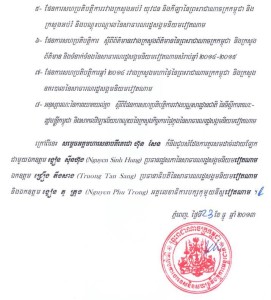
From the reaction of Premier towards the demonstration (he rejected the demand of the peaceful mass demonstration, watch clip below) including this letter accusing the demonstration as an attempt of coup detat, including the trip of Premier and his team to VN this coming Thursday, December 26, 2013, encouraged us to hold a belief of “hard line political leadership of Cambodia”.
What next…?
The peaceful mass demonstration has been occurred in Cambodia since the campaign in June, the election day in July and this post election. This ongoing daily basic rally has surely established a new culture of Cambodia of : non-violence principle, political participation, grassroots democracy, fearless and capable citizens etc.
Many people have compared the demonstration in Cambodia to that of in Thailand. Of course, the two demonstrations are very different from each other. In Thailand, the cause leading to the mass demonstration is a historical conflict between two government parties. But in Cambodia, the cause leading to mass demonstration come from the election which is found unfair, unfree and fraudulence. National Election of Cambodia (NEC) has rigged the election and produced false result, according to joint statement of 20 NGOs. It said 20% of the eligible ballots were stolen. NEC itself has been built dependently on the powerful CPP party. The procedures of the election have been seen in vast disfranchisement and bias. Until the last minute of the election result declaration, the NEC was seen under pressure of military and policemen deployed by the government. So it is candid to assume that the people who come to the street to demonstrate against the election have shared the same emotion: the perception of cheating by the NEC and this electoral committee has plundered their will. All Cambodian people cannot accept this act of cheating.
Cambodia might be able to model other Asian countries about non-violence protest and peaceful mass demonstration. CNRP has strongly committed to non-violence and peaceful mean. And this new emerge of political agenda should be credited to all Cambodian people. And if we think about organized groups, the credit must offer to all stakeholders especially CNRP, CPP, NGOs and Khmer community diaspora worldwide.
By Sophoan
Posted in Culture, Education, Leadership, Politics, Social | Comments Off on Reflection of Political Leadership of Cambodia from Past to Present
Tags: Political Leadership
The lost Buddha relic impacts on the treasure of Cambodia nation
Buddha’s relic is very important and sacred treasure for Cambodian Buddhists while it was stolen on December 10, 2013 at the Udong Sakyamuni Buddha stupa in Kandal province about 20 km. from Phnom Penh. The loss of this  treasure has triggered sadness for all Cambodians. The relic has symbolized the national holiness, the faith, the pride and the soul of this nation. To be known as Buddhism institution in this nation, the strong pillars comprise of:
treasure has triggered sadness for all Cambodians. The relic has symbolized the national holiness, the faith, the pride and the soul of this nation. To be known as Buddhism institution in this nation, the strong pillars comprise of:
- Buddha or the Founder refers to Buddha statue (imitating the actual Buddha image in shape of iconic statue or painting. Buddha said Yo Mam Passati So Dhammam Passati means one who see him see his teaching) and the actual relic of the Buddha. Relic was spared to different locations by the Tona Brahma after the cremation of the Lord Buddha and Cambodia is believed to receive on piece of hair offered by Sri Lanka government during the reign of King Norodom Sihanouk and Supreme Patriarch Chuon Nath.
- Dhamma or the Teaching refers to the Tipitaka, Pariyati and Pali language school, Samadhi practice and Buddhist learning.
- Sangha or the Community refers to four disciples such as Bhikkhu, Bhikkhuni, Upasaka and Upaseka
- Rituals or Sasanapithi refers to both disciplinary rituals such as ordination, pavarana-kamma and Kathina etc.; and ordinary rituals such as Visakha Bochea, Pchum Ben etc.
- Sacred Place/Worshiping Place or Sasanasthan refers to Bodhi tree, Temple, Buddha Statue and Relic
Observing from these five pillars, the loss of relic is comparing like losing one of the key pillars. Note that, in Cambodia, the stolen relic is the most important one in this nation.
If the authority can not return back the relic from thieving this time, there will be disastrous consequences in the future.
Posted in Culture, Social | Comments Off on The lost Buddha relic impacts on the treasure of Cambodia nation
Tags: Buddha relic
Buddhism and Human Rights Day

Dhammayietra/Sithi or Dhamma/Sithi March to propagate and educate the Human Rights. Courtesy: Facebook
Buddhism and Human Rights is inseparable. There are many times, many places and many events that Lord Buddha preached on non-violence, tolerance and compassion. Human rights declared by the United Nations is the universal rights to all human beings. The UN’s charter considers human rights as the most important pillar comparing to other provisions adopted by this new world body in encountering human problems. But Lord Buddha advocated beyond human dimension by introducing the respect of animal rights and natural rights. The UNs might experience difficulty in handling with animal and natural rights while the literal meaning of rights itself has invoked controversy and implementability.
Buddhism and Human Rights
Many studies and literature found the life of Buddha, his teaching and his Sangha community have collectively worked towards the safeguarding of human rights. Buddha himself was born in the forest, he enlightened in the forest and passed away (Parinibbana) in the forest. When he was a young prince, he saved life of a swan which was shot by his relative named Devadatta. His teaching significantly articulated Sila or precepts or code of conduct to instill self-discipline and avoiding violating or harming on others as the preliminary discourse, or it is Vinaya in the Tipitaka that all members of the Sangha (Bhikkhu, Bhikkhuni, Upasaka and Upaseka) must undertake. And by this undertaking, the members of the Sangha can empower the pathway to practice deeper and more fruitful level of attainment such as Dhamma discourse, Vipassana meditation and Abhidhamma. The Sangha community is the model of human community expressing the respect of human rights by observing different precepts such as Five Precepts, Eight Precepts, Ten Precepts and Four Precepts etc. Among those precepts, Five Precepts are fundamental for all human beings to observe in order to fully defend self well-being and the well-being of others.
- First precept of human rights is to avoid all types of physical abuses such as beating, injuring, killing and destroying lives of others, by undertaking loving-kindness and compassion towards all beings.
- Second precept of human rights is to avoid stealing or commit bribing/corrupting in a society, by undertaking self-restrain of greed and project a life of right livelihood.
- Third precept of human rights is to avoid committing sexual misconduct such as raping and dishonesting one’s own partner, by undertaking self-restrain of sexual craving and be honest or enjoying only the married partner.
- Fourth precept of human rights is to avoid telling lie, using slandering words, idle talk and back-biting talk, by undertaking trustworthy speech, harmonious language and useful words.
- Fifth precept of human rights is to avoid alcoholically addicting or using of addictive drugs, by undertaking mindfulness and mental stillness.
Why December 10?
Human Rights Day was universally declared by the United Nations on December 10th, 1950 to the attention of the people of the world, it is the universal human rights declaration that human beings must be able to achieve. The day is probably part of the reflection of the proxy war as well as the world division during the WW1 and WW2. Otherwise, the corporation of the new world order has been garnered by many scholars and movements around the world. The establishment of the UNs is among those pragmatism and idealism. More than this, the coming of Enlightenment era jumped up from the dark era as it is called the age of human endeavor.
Cambodia and the Human Rights Day
It is the national holiday and it has been present in this country probably since the country was become the permanent member of the United Nations. Cambodia has to abide by many stipulates it has signed including the strengthening the rule of law, democracy, and the respect of human rights.
This year, civil society has fully performed their duty to advocate the respect of human rights at the grassroots level by making five different Dhamma and Sithi Marches from different five directions. The marches have begun on December 1st from remote provinces heading towards Phnom Penh via national road number #1, #3, #4, #5, and #6. The marches are led by Buddhist monks who are reverent by the people and bystanders. The people offer food and financial support in exchanging for merits, Dhamma enlightenment and blessing from the monks. There are many grassroots people were preached on the meaning of human rights, participated with the marches and provided both mental and material support. But there are many temples and places that local authority tried to obstruct the marches and sometime the marches leadership and participants must block the road in handling with the local authority.
The theme of human rights day this year (10 December 2013)
Cambodian civil society has titled “No Justice, No Peace or Solidify to Fight Against Social Injustice” as their main theme this year, the CNRP called for the public attention of: “people rights to elect the capable leader”, while CPP celebrated human rights day on their theme of: “December 2nd is the significant day to liberate Cambodia from the Khmer Rouge or celebrating this day strengthening the respect of human rights”. Note that this year is the remarkable year that CPP celebrated “Human Rights Day”. For the United Nations, this year is the 20th commemoration of the 20 years working for your rights. UN-Secretary general Ban Ki-moon said: “As we commemorate the 20th anniversary of the Vienna Declaration and Programme of Action, let us intensify our efforts to fulfill our collective responsibility to promote and protect the rights and dignity of all people everywhere.”
The politics of Human Rights Day

Local authority locked the temple’s door to block marchers from taking a rest. Local authority is likely using power above the chief monk and public asset like the temple that is built by the altruism of the devotees.
Courtesy: Faceook
Human rights day this year in Cambodia has become outstanding comparing to previous years. The 10 days preparation of Dhamma marches by the civil society is seen outstandingly. The new strongest emergent Cambodia National Rescue Party (CNRP) shall organize peaceful mass demonstration in both Phnom Penh and Siem Reap for the commemoration of this day is seen very much significant. But it has been rare for the Cambodian People Party (CPP) which is the government-led party will also commemorate this day, and this party has used this day for the political advantage by marching December 2 to that of December 10 of the Human Rights Day. December 2nd, according to the CPP, it is the birth of this party in order to finish the terror regime of Pol Pot. But many scholars and observers have remarked this attempt as the hidden agenda of Vietnamese influence over CPP. According to those observers, the December 2nd which is the date of the creation of the CPP, Vietnam solely created this party in order to achieve its goal of playing political hegemony over Cambodia. First Vietnam helped the Khmer Rouge to power. Second Vietnam helped the CPP to topple the Khmer Rouge in reprisal. The people of the Khmer Rouge and the people of the CPP have been coming from the same root per se.
What will you do next?
Buddha preached that: “Silena Sukhatena Yanti, Silena Phokhasomphada, Silena Nipputena Yanti, Tasma Silam, Visodhaye” or literally means “Precepts or human rights shall bring us happiness, shall bring us the wealth, shall bring us to Nibbana; so everyone must undertake the five precept or human rights attentively and heedfully”.
By Sophan
Posted in Culture, Economics, Education, Leadership, Politics, Researches, Social | Comments Off on Buddhism and Human Rights Day
Tags: Buddhism and Human Rights, Human Rights Day












